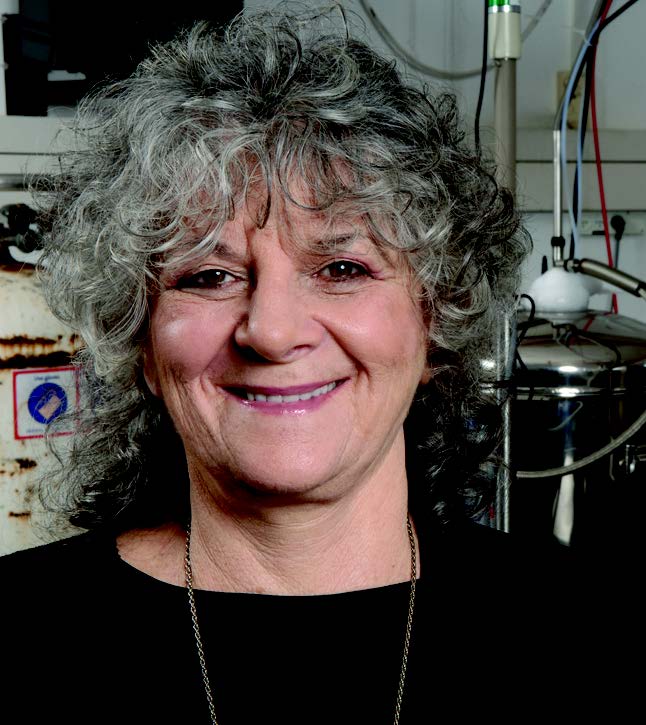
Prof. Ada Yonath
When harmful bacteria become resistant to medicine, the cost—to both human health and society—is high. According to the World Health Organization (WHO), microbial resistance not only kills people, but also impedes control of infectious diseases, damages trade and economies, and threatens to return us to the pre-antibiotic era.
Drug resistance is a growing problem, as decades of misuse and overuse of antibiotics have resulted in the evolution of bacteria that do not respond to such medicines, leading to a rise in “superbugs” such as methicillin-resistant Staphylococcus aureus (MRSA).
The Weizmann Institute of Science’s basic research is curiosity-driven, and applications from such research can be unexpected. When Prof. Ada Yonath of the Department of Structural Biology began studying the ribosome—the cell’s protein factory—as a young researcher in the 1970s, she was not planning to lay the foundation for the next generation of antibiotics.
“Resistance to antibiotics is one of the biggest medical problems of the twenty-first century, so there’s an urgent need for additional effective drugs.”
Hoping to understand the way ribosomes function by determining their three-dimensional structure, she first needed to find a way to crystallize them. “Many very good groups of scientists had tried to crystallize ribosomes and failed,” she says. “That’s why it was considered a formidable task when I started.”
Collaborating with scientists at the Max Planck Institute for Molecular Genetics in Berlin, Prof. Yonath challenged the common approach, moving to experiments with ribosomes from robust bacteria on the assumption that these should deteriorate less when prepared, and therefore be more suitable for crystallization. She extracted ribosomes from thermopile bacteria and, after many thousands of attempts, succeeded in creating the first ribosome microcrystals in 1980. Then she moved on to ribosomes from tough Dead Sea bacteria. In order to examine the ribosome’s structure, she bombarded the crystals with x-rays. Through innovative experiments in which she exposed the ribosome crystals to extremely low temperatures (-195°C) to prevent them from disintegrating under the x-ray barrage, she created the technique known as cryocrystallography, which is now used in almost all structural biology labs around the world.
In 2000, Prof. Yonath and her team solved, for the first time, the complete spatial structure of both subunits of a bacterial ribosome. As some antibiotics work by blocking the function of ribosomes, she realized she could now use her insights into ribosomal structure to learn how, exactly, the drugs are able to do this.
“More than 40 percent of the clinically useful antibiotics target the ribosome and arrest or hamper protein biosynthesis,” explains Prof. Yonath. “Erythromycin, for example, was the first clinically used antibiotic that binds to the ribosome.”

Once again collaborating with the Max Planck Institute, Prof. Yonath identified exactly how five antibiotics—chloramphenicol, clindamycin, clarithromycin, erythromycin, and roxithromycin—eliminate pathogenic bacteria by preventing them from producing proteins. The team did this by creating crystals that captured theindividual complexes formed between each drug and the bacterial ribosome. Next, they used x-ray crystallography to examine these crystals and found that, for the first time, they were able to see precisely how the antibiotics bind to a specific site on the ribosome, effectively shutting down its machinery. Since these findings were published in Nature in 2001, Prof. Yonath and her colleagues have gone on to reveal the mechanism of action of almost all antibiotics that work by targeting the ribosome.
“Our studies are providing structural information that can be used for the design of new and improved antibiotic drugs,” says Prof. Yonath. “Resistance to antibiotics is one of the biggest medical problems of the twenty-first century, so there’s an urgent need for additional effective drugs.”
One way to control or minimize antibiotic resistance, notes Prof. Yonath, is to use synergism: combinations of two drugs that are more effective together than either would be alone. Recently, her team collaborated with researchers at the University of Illinois in Chicago and the University of Hiroshima in Japan to identify one such synergistic pair, the antibiotics lankacidin and lankamycin.
Antibiotic-resistant “superbugs” such as MRSA are on the rise worldwide, causing death, impeding control of infectious diseases, damaging economies, and threatening to return us to the pre-antibiotic era.
Prof. Yonath is a member of the U.S. National Academy of Sciences, and her work has earned high-profile accolades, including the Israel Prize, the Wolf Prize, and the L’Oréal-UNESCO Award for Women in Science, which she received in 2008 for her “structural studies of the protein-synthesizing system and the mode of action of antibiotics.” In 2009 she was awarded the Nobel Prize in Chemistry, along with Dr. Thomas Steitz of Yale and Dr. Venkatraman Ramakrishnan of the Medical Research Council Laboratory of Molecular Biology in Cambridge, U.K., for deciphering the structure and function of the ribosome.
For Prof. Yonath, one of the best things about receiving the Nobel Prize was seeing how it sparked the public’s interest in learning about the ribosome and the scientific method. “The prize had much more impact than I expected,” she says. “It made many people more aware of science, of the fact that the life of the scientist is not always dull, and that innovation has impact.”
Prof. Ada Yonath is the Director of the Helen and Milton A. Kimmelman Center for Biomolecular Structure and Assembly and is the Martin S. and Helen Kimmel Professor of Structural Biology.
